

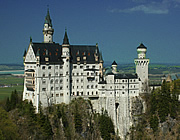
King Ludwig's fairytale castle of Neuschwanstein was the primary reason for this trip, but we discovered so much more both in Munich and the surrounding area, not least the treasures and tapestries of the Residenz, and the amazing opera grotto at Linderhof.
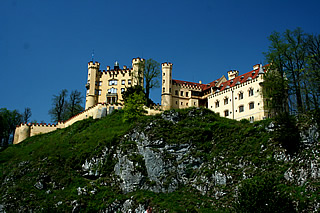
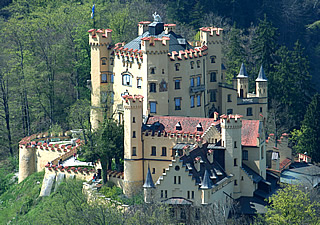
Driving from Basel it made sense to visit Neuschawanstein before checking in at our hotel in Munich. We'd reserved tickets beforehand to be sure we got in. The tickets are for a particular entry time and all the tours are with a guide, and no photographs allowed, unfortunately, except for one of the view from a window in Hohenschwangau.
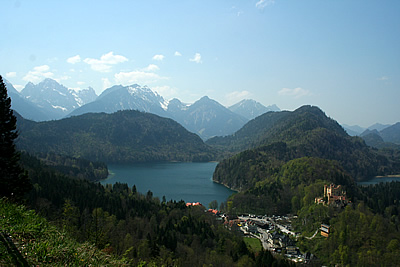
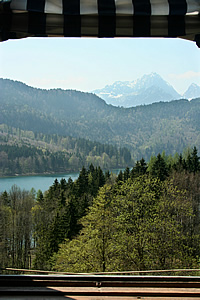
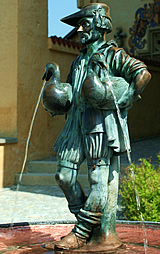
There are actually two castles at this location, south west of Munich: Hohenschwangau is within easy walking distance of the ticket hall - Neuschwanstein a somewhat longer walk uphill - many people take the horse-drawn carriages.
Schloss Hohenschwangau was built by Maximilian II of Bavaria, Ludwig's father, and it is where Ludwig spent much of his childhood. When his father died in 1864 Ludwig became king at the age of 18. Though briefly engaged to the younger sister of his cousin Empress Elizabeth of Austria (Sisi - Ludwig was her favourite) he never married.
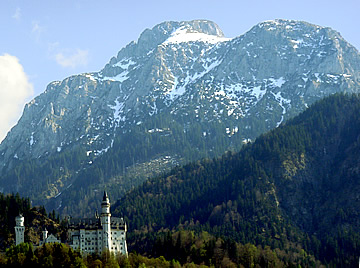
Scloss Hohenschwangau is in a wonderful location above the Schwansee (Swan Lake) and the larger Alpsee in the mountains very close to the border with Austria. It feels quite a homely place, for a castle. In Ludwig's bedroom the ceiling had stars which could be lit with oil lamps in the room above, and a moon which went through the phases, waxing and waning.
Ludwig liked the area so much that when he decided to build his own fantasy castle he chose a spot close by but even higher in the mountains.
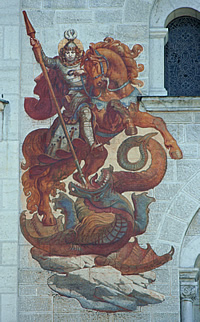
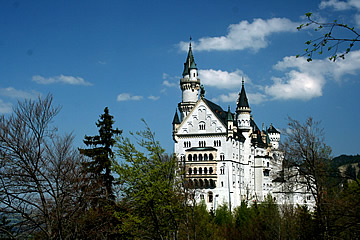
Ludwig was an extremely romantic character. His castle reflects his longing for the medieval time of chivalrous knights when a king's rule was absolute.
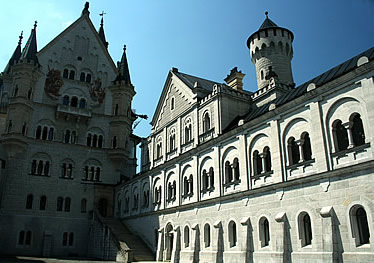
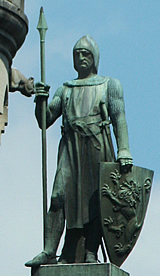
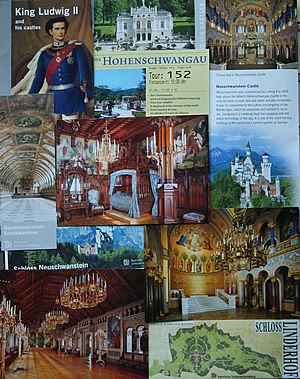
Inside the castle the medieval theme is continued in a series of richly ornate rooms. Wall paintings depict scenes from northern myths such as Tristan and Isolde in the King's bedroom. This is probably the most gothic room in the castle with an intricately carved wooden bed. The wash basin here has a lovely swan water fountain. Everywhere there are swans - Ludwig's heraldic animal as a Knight of Schwangau. The most curious room has to be the grotto: an artifical rock cave.
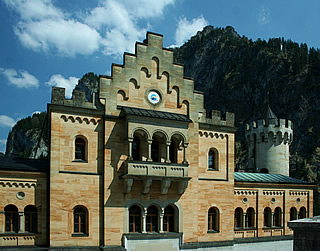
The Throne hall is fabulous, partly in the style of a Byzantine church with a domed roof painted in blue and gold stars and an intricate mosaic floor of the earth and its plants and animals. The Singers Hall, walls painted with scenes from the saga of Parzifal and the Holy Grail and with enormous ornate chandeliers, is another homage to medieval times, influenced by Wartburg Castle, where it is said a legendary poetry contest took place in the thirteen century - the theme of Wagner's opera Tannhäuser. Ludwig was a huge admirer of Wagner and became his patron. The themes of his operas exactly matched the king's love of medieval myths and legends.
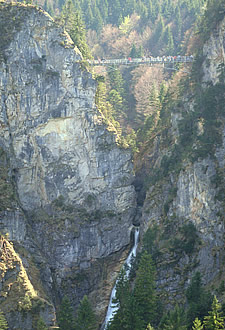
Ludwig spent a fortune on his building schemes - he built the castles of Linderhof and Herrenschiemsee as well as Neuschwanstein, as well as numerous other projects. He ran up an enormous debt but continued with his grandiose plans. Unwilling to perform any state function his government sought a way to remove him. The method was to declare him insane and replace him with his uncle, Luitpold. On rather dubious grounds - he was never actually examined for instance - Ludwig was declared incapable of ruling and deposed in June 1886. He was taken to Castle Berg on the Starnbergsee and four days later, on the thirteenth of June, he and his psychiatrist were found drowned in the lake. A very mysterious end for this enigmatic monarch.
The classic shot of the castle is from Marienbrücke high above the Pöllat Gorge - Ludwig used to come up here in the evenings to look at his wonderful creation - in winter by sleigh.
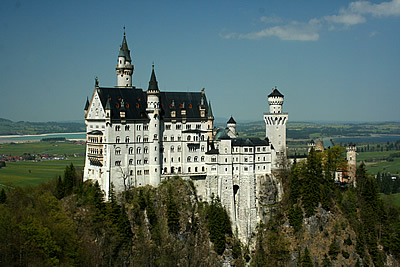
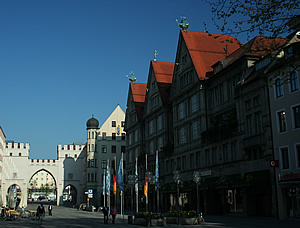
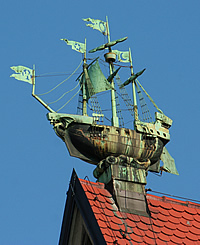
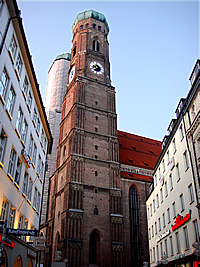
There's been a settlement here since the ninth century when a village developed close to a Benedictine monastery - hence the name of the city, Mönch being German for monk. In the thirteenth century Munich became the ducal residence of the Wittelsbachs. Munich was the capital of Bavaria from the early sixteenth century reaching its zenith in the nineteenth century when it was declared a Kingdom ruled by kings of the House of Wittelsbach after an 1806 alliance with Napoleon - Ludwig II was the fourth King of Bavaria.
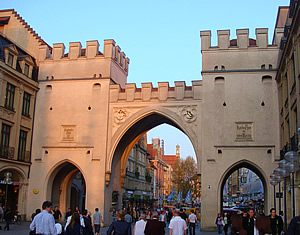
We wandered quite a bit around Munich to get a flavour of the city. Karlstor was the western entrance to the medieval city in the early fourteenth century. Neuhauserstrasse inside the gate is pedestrianised for its length through what used to be the ancient city centre. Passing the Jesuit St Michael's Church and with glimpses of Frauenkirche just off the street to the north, it leads directly to Marienplatz .
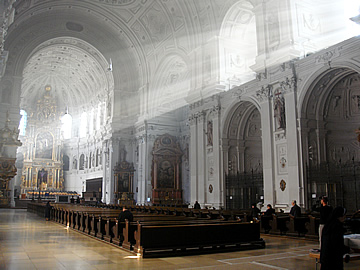
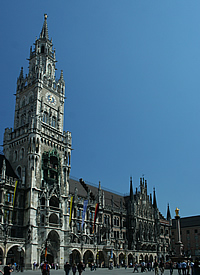
The twin onion-dome towers of the fifteenth century Frauenkirche dominate the skyline. Very unusually it is made of brick in a quite austere Gothic style. It was restored after damage caused by air raids in the Second World War.
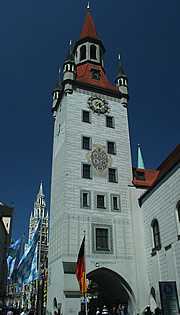
On the north side of the vast Marienplatz, where public events are held, is the nineteenth century neo-Gothic New Town Hall. The beautiful Glockenspiel in its tower has two levels of figures depicting a tournament in honour of the marriage of Duke Wilhelm V to Renata of Lorraine above and below a Dance of the Coopers.
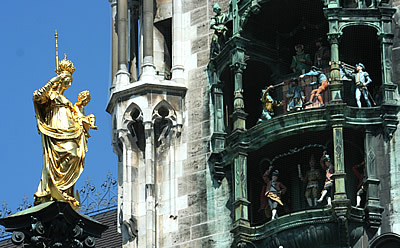
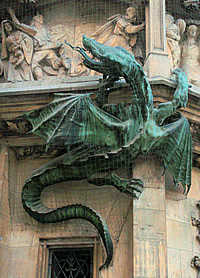
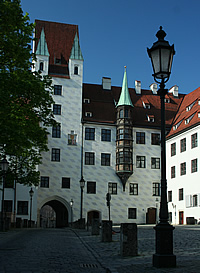
Just east of Marienplatz is the Old Town Hall, dating from the end of the fourteenth century - rebuilt after damage during the Second World War.
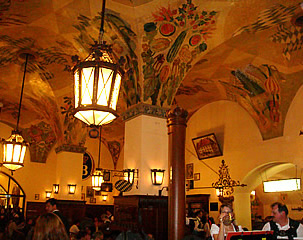
The Alter Hof, just north east of Marienplatz, was the home of the Wittelbachs in the thirteenth and fourteenth centuries. It's a very peaceful spot and the buildings are beautiful - though once again reconstructed after Second World War damage.
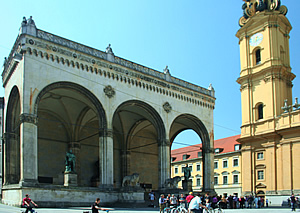
Nearby is the sixteenth century Hofbrauhaus am Platzl which is very popular with tourists - a typical German beer hall, founded as the brewery to the Alter Hof, it has an oompah band and dirndl-dressed witresses. It was oppressively hot when we popped in to take a look but nevertheless doing good business. The Hofbrauhaus was one of the beer halls used by the Nazi Party to hold meetings and proclaim policies (Hitler had moved to Munich at the age of 24), though not the site of the famous Beer Hall Putsch of 1923. This ended with a stand-off between Hitler's followers and armed police in front of the Feldherrnhalle in Odeonsplatz. Shots were fired resulting in fatalities on both side. Hitler escaped, though injured, and was arrested two days later. It was during the following year in prison that he wrote Mein Kampf (My Struggle).
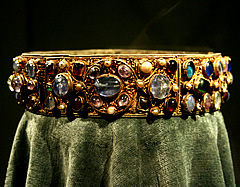
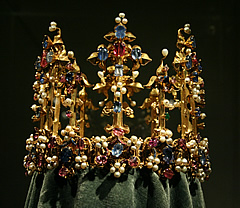
The Palace of the Wittelsbachs in Munich (Munich Residenz website), their residence after the Alter Hof, contains endless sumptuous state rooms with enormous beautiful tapestries. We made a huge tour of the palace and museum, including the treasury which holds an exquisite English crown, made around 1370 it is the oldest English crown in existence, gold encrusted with emeralds, rubies, sapphires and pearls. It came to the Wittelsbachs as part of the dowry of Blanche, the eldest daughter of King Henry IV of England, when she married Louis, son of King Rupert, in 1401.
The crown of the Empress Kunigunde, wife of the Emperor Henry II of Bavaria, is even earlier, having been made in the early tenth century, and though of much simpler design is also very beautiful.
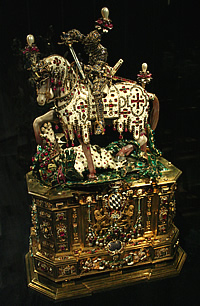
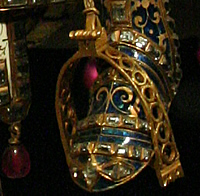
Probably the most celebrated piece is the magnificent late sixteenth century Statuette of St George of gold, enamel and silver-gilt with details picked out in diamonds, rubies, emeralds, opals, agate, chalcedony, rock crystal and other precious stones and pearls. It was made to house a relic of St George sent in 1586 to Duke Wilhelm V of Bavaria by his brother the Archbishop Ernst of Cologne. The face of the knight is carved from boxwood and said to resemble Wilhelm.
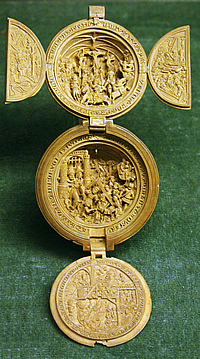
However, not everything here is made from precious metals and gems. For instance an exquisitely carved Flemish boxwood rosary bead from around 1500, which opens to reveal intricately detailed scenes. The one shown here has images of Christ on the road to Calvary and the crucifixion.
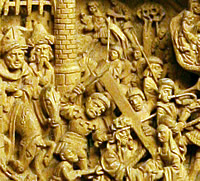
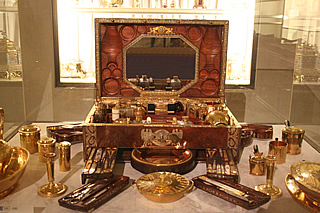
A magnificent early nineteenth century travelling set was made for Marie Louise of France when she became the second wife of the French ruler Napoleon, a gift from the city of Paris. It is remarkable not just for the workmanship and materials - silver-gilt, gold, mother-of-pearl, tortoiseshell, ivory and ebony - but for the range of items. It contained over 120 pieces including a dinner service for two, extensive set of toiletry items, writing and sewing implements, seals, opera glasses, a screwdriver, drill, metre ruler and even dentist's instruments.
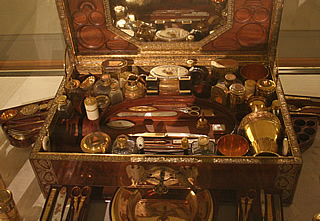
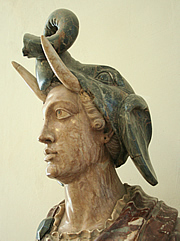
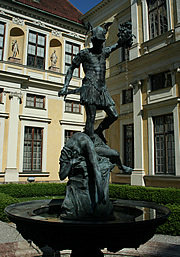
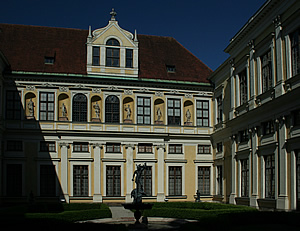
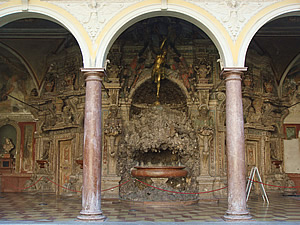
Between the treasury and the state rooms one skirts the Grottenhof - an open courtyard with a statue of Perseus slaying Medusa. This statue is a copy - the original can be seen indoors.
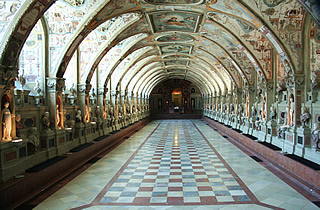
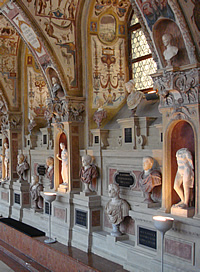
Past the grotto is the entrance to the most impressive room in the palace, the 66 metre long Antiquarium, so-called because it was built by Duke Albrecht V to house his collection of antique sculptures. It took three years to create the room, completed in 1571, but over the next twenty years it was transformed by Albrecht's successors into an even more lavish banquet hall, with painted walls and ceilings, an elevated dais at one end, and a fireplace. The paintings include, above the windows, views of towns, markets and palaces in Bavaria. It's hard to imagine that the palace was all but destroyed in the Second Wolrd War.
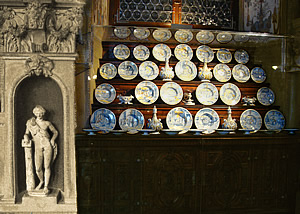
Near the entrance to the Antiquarium is a display of decorated blue and yellow pottery: wine bottles, candlestick holders but mostly plates and dishes - including a fine depiction of Hannibal and his elephants crossing a river. It's quite obvious the artist had never seen an elephant from their relative size and appearance but they're very endearing, as are most "primitive" images of exotic beasts.
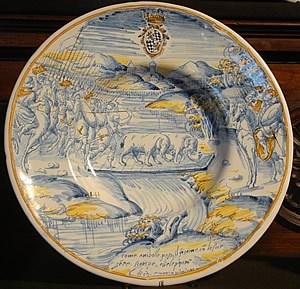
Collections of blue and white oriental porcelain including Ming dynasty and Imari ware, lead into the state rooms. The tapestries in these rooms are magnificent.
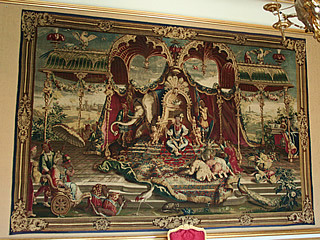
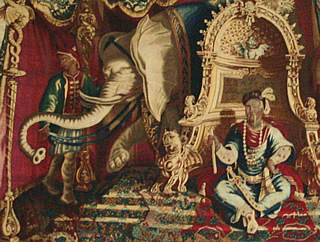
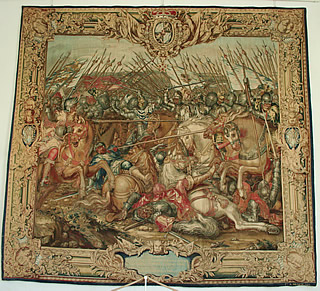
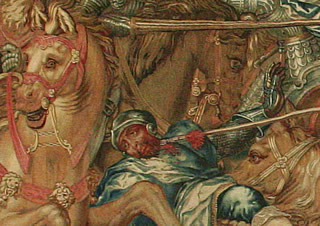
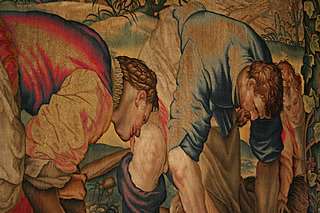
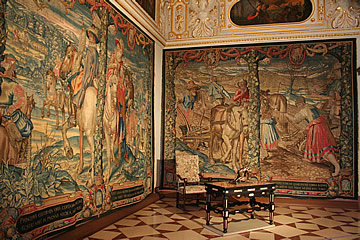
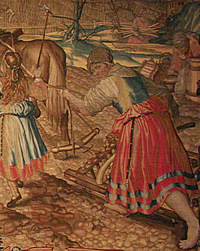
In the Trierzimmer the early seventeenth century tapestries depict the seasons of the year, which makes a nice change from battles and famous people!
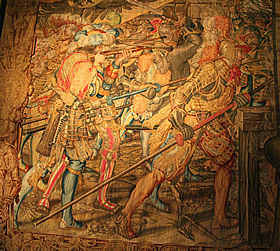
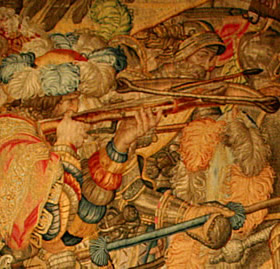
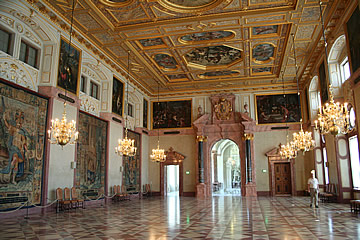
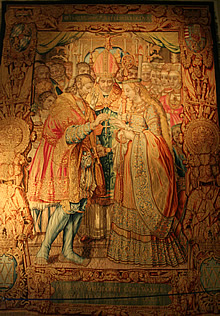
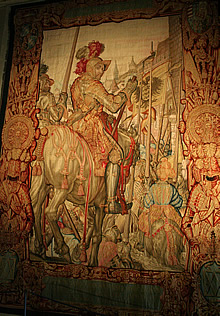
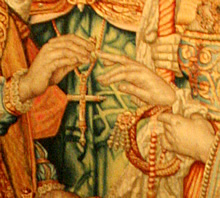

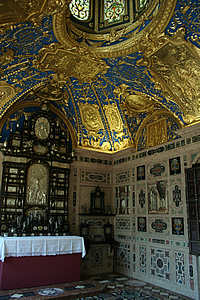
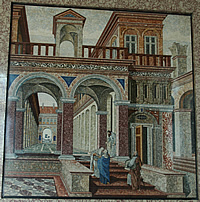
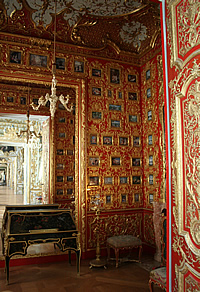
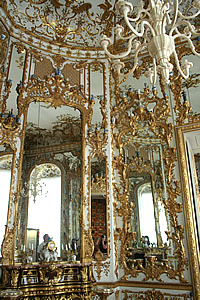
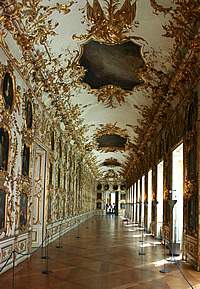
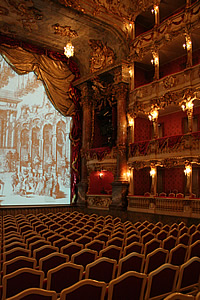
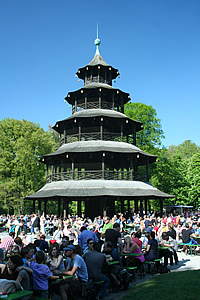
The Reiche Kapelle was dedicated in 1607 and was where Duke Maximilian 1st kept his precious collection of relics of saints. A deep blue and gold ceiling has a central coloured glass lantern and the walls are covered with a material called "scagliola": coloured stucco panels, polished to look like marble.
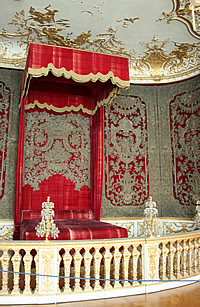
The state bedroom is more a display area than a comfortable room to sleep in - this followed the French court fashion of the time of Elector Karl Albrecht of Bavaria. Adjoining it is an elaborate red and gold Cabinet of Miniatures. Along with much of the palace it was all but destroyed by bombs in the Second World War and has been painstakingly recreated.
Nearby is the white and gold Porcelain Cabinet, once the home of the treasures of the Wittelsbachs it now houses a collection of fine porcelain arranged on the gilded decorative rococo framework covering the walls.
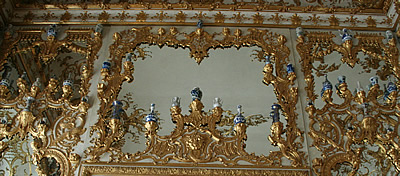
The Ancestral Gallery is a long, eighteenth century white and gold rococo room designed to display protraits of the extended Wittelsbach family and to emphasise their importance - not least by strategic marriage! These connections enabled Karl Albrecht to claim successfully his right to the Imperial throne in 1742.
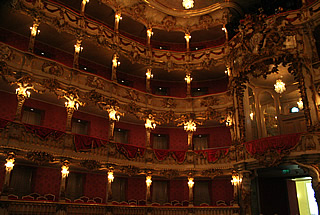
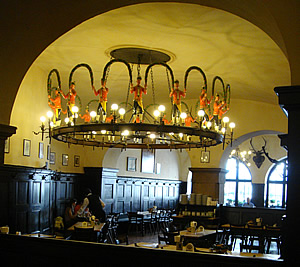
Near the Residenz is the entrance to the Cuvillies Theatre - not the original building which was also destroyed in the Second World War. Many of the interior carvings and fittings had - like the precious objects in the Residenz - been removed to safety, and these were renovated and installed in this new building.
Though I'm not at all keen on rococo, the sumptuous red and gold and ornate decoration - including figures "supporting" the tiers - combine to create a luxurious theatrical location.
We had some pretty decent food in Munich: at Ayingers excellent beef, bacon and green beans and a traditional pork, bacon and sausage dish - though I managed not to avoid spätzli which I dislike. At Zum Augustiner (one of several owned by the Augustiner Brauerei) lamb and suckling pig with excellent desserts of apfel strudel and a superb crême brulée eisdessert with cherries. And of course an excellent range of beers.
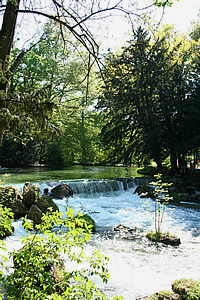
The Englischer Garten is an eighteenth century park in the informal English style. It runs from the centre to the north east of the city, quite large, and very popular with the city-dwellers. We took the U-bahn a few stops to the north and entered the park near Kleinhesselcher See then walked back south through the park toward the city centre. Lots of people had the same idea - it was a scorching April day on Easter weekend. Near the southern end there is a Chinese pagoda with a very welcome beer garden - heaving with customers!
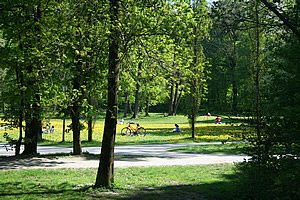
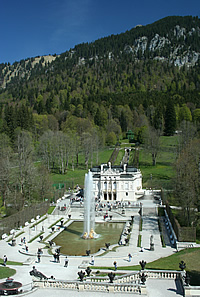
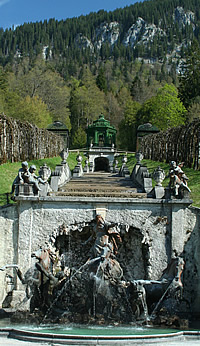
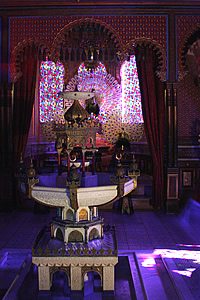
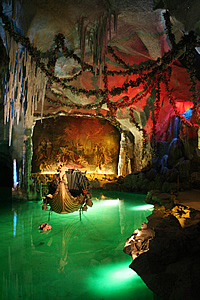
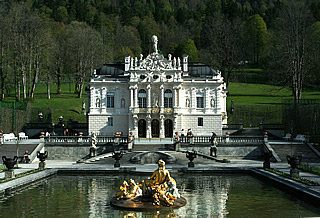
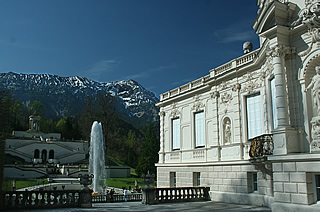
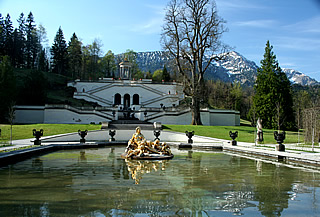
Ludwig II built this jewel of a small palace in south west Bavaria, inspired by Versailles, and here tried to live a fantasy life, cutting himself off as much as possible so as to maintain an illusion of living in the past. For instance his dining table was laid on the floor below and was raised up through the floor of his room so that he could avoid seeing servants!
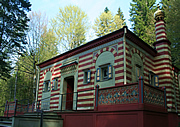
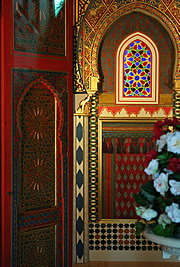
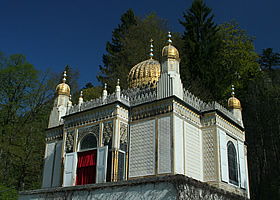
The interior is stuffed with gold leaf rococo decoration. Outside are beautiful fountains - the one in front of the palace is turned on every half hour, a Moorish Kiosk and a Moroccan House, the interior gaudily decorated with multi-coloured patterened walls, windows and brilliant peacocks.
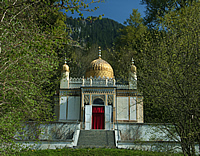
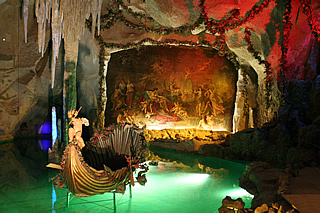
But the most wonderful of Ludwig's creations is buried in the mountainside: a most amazing Venus Grotto where the king had opera staged, sitting high up above a small lake. There is an illuminated waterfall to one side and variable coloured lighting over the whole scene. With Tannhauser playing in the background it is here that one gets the best sensation of the character of this most mysterious of monarchs.